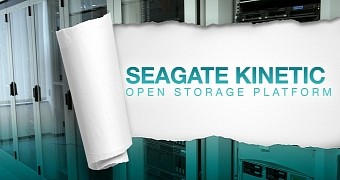Kinetic Open Storage Platform made by Seagate with input from major hard drive manufacturers like Toshiba Western Digital and Cisco is now open to all companies.
Announced in 2013, the Kinetic Open Storage Platform was meant to be a major boost to data center storage industry. By placing Ethernet connectivity in direct contact with its storage devices that were powered by a series of programming interfaces that allowed direct drive-to-drive data transfers without a central controlling system, the new system wanted to guarantee absolute transfer speeds without any bottlenecks.
The type of hardware involved or when it was supposed to be available was unknown; the announcement was not meant to give much details about the system, announcing only that it had two major enterprise storage software vendors on board.
However, the most surprising things about the new system is that now Kinetic Open Storage Platform is an open system. By opening the doors for the Kinetic platform, the system can be placed together with the Linux Foundation as a Collaborative Project. To the surprise of everybody, Kinetic is developed by Seagate together with archrival Toshiba and Western Digital.
Big names are involved, but not the biggest of them all: Samsung
Networking giants like Dell and Cisco are also contributing to Kinetic. The specifications released by Seagate about the project include both the hardware side, with integrated Ethernet, and software side that basically helps the interface store data in a more efficient way.
This way the company hopes it will gather enough popularity to actually compete with the advances Toshiba, and most importantly Samsung, is gaining on the V-NAND flash memory technology. It's no wonder Samsung, which recently managed to create the world's largest hard drive which not coincidentally is an SSD, is not specified to participate in this Kinetic project.
Although announced as being open, the Kinetic system is actually built by Seagate, and although other large companies are contributing to it, it's impossible for Seagate not to ask for some form of royalties of usage fees. Since there are no obvious or direct gains for Seagate, it's very hard to speculate why Seagate decided to initiate this strategic move. Only time will tell. It seems a hidden battle between the South-Asian SSD giants, Toshiba and Samsung, versus the American HDD alliance, WD and Seagate, is in full swing.

 14 DAY TRIAL //
14 DAY TRIAL //